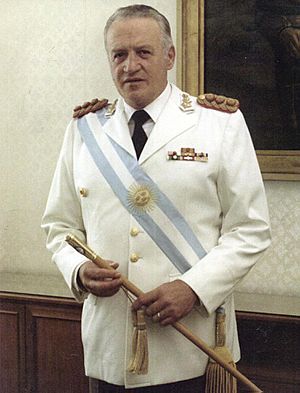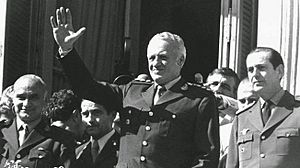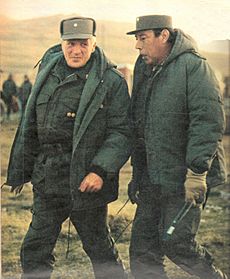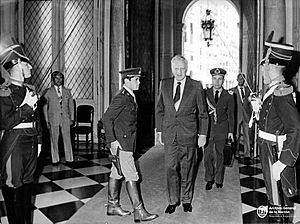Leopoldo Galtieri facts for kids
Quick facts for kids
Leopoldo Galtieri
|
|
|---|---|

Official portrait, 1981
|
|
| President of Argentina | |
|
De facto
|
|
| In office 22 December 1981 – 18 June 1982 |
|
| Appointed by | Military junta |
| Vice President | None |
| Preceded by | Carlos Lacoste (interim) |
| Succeeded by | Alfredo Oscar Saint Jean (interim) |
| Personal details | |
| Born | 15 July 1926 Caseros, Argentina |
| Died | 12 January 2003 (aged 76) Buenos Aires, Argentina |
| Spouse |
Lucía Noemí Gentili
(m. 1949) |
| Children | 3 |
| Alma mater | Colegio Militar de la Nación |
| Profession | Military |
| Signature |  |
| Military service | |
| Allegiance | |
| Branch/service | |
| Years of service | 1944–1982 |
| Rank | |
| Battles/wars | Falklands War |
Leopoldo Fortunato Galtieri (1926–2003) was an Argentine general and politician. He served as the President of Argentina from December 1981 to June 1982. Galtieri was a military leader who took power during a time when the army ruled the country. This period was known as the National Reorganization Process. He led the country as part of a group of military leaders called the Third Junta.
Galtieri was a top engineer in the Argentine Army. He strongly supported the military takeover in 1976. This helped him become the army's top commander in 1980. Galtieri became President after another general, Roberto Eduardo Viola, was removed from power. During his time, Argentina became a close friend of the United States. He also made changes to the economy and supported groups fighting in Nicaragua. His government was involved in a sad period called the Dirty War, where many people disappeared.
People in Argentina became unhappy with Galtieri because of problems with human rights and the country's economy. To try and gain support, he ordered the invasion of the Falkland Islands in April 1982. However, Argentina lost the Falklands War in June. After this defeat, Galtieri was removed from power. This led to Argentina becoming a democracy again in 1983. He was later put on trial for his actions during the war. He received a pardon in 1989 but faced new charges before his death in 2003.
Contents
Early Life and Military Career
Leopoldo Fortunato Galtieri was born on July 15, 1926, in Caseros, Buenos Aires, Argentina. His parents, Francisco Rosario Galtieri and Nélida Victoria Castelli, were working-class and of Italian descent.
In 1943, at the age of 17, he joined the National Military Academy. He studied civil engineering there. His early military career was as an officer in the engineering part of the Argentine Army. He continued his engineering studies until the mid-1950s.
In 1949, Galtieri graduated from the US Army School of the Americas. Later, in 1958, he became a professor of engineering at the Senior War College. Galtieri was married to Lucía Noemí Gentili. They had three children together.
Rise to Power
In 1975, after more than 25 years as an engineer, Galtieri became the commander of the Argentine engineering corps. He strongly supported the military takeover in March 1976. This event removed President Isabel Perón from power. It also started the National Reorganisation Process, which was a military government in Argentina.
This takeover helped Galtieri move up in the military ranks. He became a major general in 1977. By 1980, he was the commander-in-chief of the army. During the military government's rule, many basic rights were suspended. Trade unions and political parties were banned.
This period was known as the Dirty War. Between 9,000 and 30,000 people who were seen as opponents of the government disappeared. Many were tortured or killed. Argentina's economy was in a very bad state before the military took over. The military leaders promised to fix it.
In March 1981, Galtieri visited the United States. He was welcomed warmly by the Reagan administration. The U.S. government saw Argentina's military rule as a way to stop communism. Galtieri supported rebel groups called Contras in Nicaragua. These groups were fighting against the Socialist government there. In August, he sent advisers to help train these groups. This support also helped Galtieri remove some rival generals.
Presidency of Argentina
On December 22, 1981, Galtieri became the President of Argentina. This happened just one week after General Roberto Eduardo Viola was removed from power. Officially, Viola resigned due to health issues. However, he was actually removed because his government could not fix the country's economic problems. This caused disagreements within the military.
As President, Galtieri kept direct control of the army. He did not appoint a new commander-in-chief.
Political and Economic Policies

Galtieri allowed some political changes. People were able to express their opinions more freely. Soon, protests against the military government became common. People also started demanding a return to democracy.
Galtieri appointed Roberto Alemann as his Economy Minister. Alemann faced a very difficult economy. He cut government spending and tried to sell off state-owned businesses. He also froze salaries while inflation was very high. The economy continued to struggle. The country's total production (GDP) fell by 5%. Business investment also dropped significantly.
One of Galtieri's close allies, General Guillermo Suárez Mason, was put in charge of YPF. This was the state oil company and the largest company in Argentina. Under Suárez Mason, the company lost a huge amount of money.
Foreign Policy and the Falklands War
Galtieri supported the Central Intelligence Agency (CIA) in its fight against the Sandinistas in Nicaragua. He was well-received during his visit to the White House. Argentina's support became the main source of money and training for the Contras during Galtieri's time as president.
However, Argentina's military cooperation with the U.S. ended in 1982. This happened when Argentina took control of the Falkland Islands. These islands were a British territory, but Argentina had a long-standing claim to them. Galtieri hoped this move would make people in Argentina happier and distract from economic problems.
The invasion was condemned by Western countries. They provided help to the British government. The British then launched military operations to take back the islands.
The Falklands War and Its Aftermath

By April 1982, Galtieri had been in office for four months, and his popularity was low. On April 2, he ordered Argentine forces to invade the Falkland Islands. These islands are a United Kingdom territory that Argentina has long claimed.
At first, the invasion was very popular in Argentina. Protests against the government stopped, and people showed patriotic support for Galtieri. Galtieri and his government wrongly believed that the United Kingdom would not fight back.
The British government, led by Prime Minister Margaret Thatcher, sent a large naval force. Their goal was to retake the islands if Argentina did not leave. The United Nations Security Council Resolution 502 demanded that Argentina withdraw immediately. Argentina did not follow this resolution. This led to a war, and on June 14, 1982, Argentine forces surrendered to the British.
Defeat and Later Life
After the defeat in the Falklands War, Galtieri was removed from power within days. He lived quietly for about 18 months while Argentina returned to democracy. In late 1983, he was arrested. He was charged in a military court for his actions during the war.
In 1986, he was sentenced to twelve years in prison. He was found guilty of mismanaging the war. His military rank was also taken away. In 1989, Galtieri and other officers received a pardon from President Carlos Menem.
After his release from prison, Galtieri lived a quiet life in Buenos Aires. He rarely gave interviews to journalists. He received an army pension. In 2002, new charges were brought against him. These charges were about the disappearance of people in the late 1970s. However, due to his poor health, he was allowed to stay at home.
Death
Leopoldo Galtieri had surgery for pancreatic cancer in August 2002. He died on January 12, 2003, at the age of 76, from a heart attack. He was buried in a small mausoleum at La Chacarita Cemetery.
Images for kids
See also
 In Spanish: Leopoldo Fortunato Galtieri para niños
In Spanish: Leopoldo Fortunato Galtieri para niños



